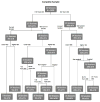Patient Characteristics Predictive of Cardiac Rehabilitation Adherence
- PMID: 28033166
- PMCID: PMC5322217
- DOI: 10.1097/HCR.0000000000000225
Patient Characteristics Predictive of Cardiac Rehabilitation Adherence
Abstract
Purpose: Cardiac rehabilitation (CR) is a program of structured exercise and interventions for coronary risk factor reduction that reduces morbidity and mortality rates following a major cardiac event. Although a dose-response relationship between the number of CR sessions completed and health outcomes has been demonstrated, adherence with CR is not high. In this study, we examined associations between the number of sessions completed within CR and patient demographics, clinical characteristics, smoking status, and socioeconomic status (SES).
Methods: Multiple logistic regression and classification and regression tree (CART) modeling were used to examine associations between participant characteristics measured at CR intake and the number of sessions completed in a prospectively collected CR clinical database (n = 1658).
Results: Current smoking, lower SES, nonsurgical diagnosis, exercise-limiting comorbidities, and lower age independently predicted fewer sessions completed. The CART analysis illustrates how combinations of these characteristics (ie, risk profiles) predict the number of sessions completed. Those with the highest-risk profile for nonadherence (<65 years old, current smoker, lower SES) completed on average 9 sessions while those with the lowest-risk profile (>72 years old, not current smoker, higher SES, surgical diagnosis) completed 27 sessions on average.
Conclusions: Younger individuals, as well as those who report smoking or economic challenges or have a nonsurgical diagnosis, may require additional support to maintain CR session attendance.
Conflict of interest statement
All authors report no conflicts of interest.
Figures
References
-
- Ades PA. Cardiac rehabilitation and secondary prevention of coronary heart disease. N Engl J Med. 2001;345(12):892–902. - PubMed
-
- Balady GJ, Williams MA, Ades PA, et al. Core components of cardiac rehabilitation/secondary prevention programs: 2007 update: A scientific statement from the American heart association exercise, cardiac rehabilitation, and prevention committee, the council on clinical Cardiology; the councils on cardiovascular nursing, Epidemiology and prevention, and nutrition, physical activity, and metabolism; and the American association of cardiovascular and pulmonary rehabilitation. Circulation. 2007;115(20):2675–2682. - PubMed
-
- Clark AM, Barbour RS, White M, MacIntyre PD. Promoting participation in cardiac rehabilitation: Patient choices and experiences. J AdvNurs. 2004;47(1):5–14. - PubMed
-
- Taylor RS, Brown A, Ebrahim S, et al. Exercise-based rehabilitation for patients with coronary heart disease: Systematic review and meta-analysis of randomized controlled trials. Am J Med. 2004;116(10):682–692. - PubMed
-
- Wenger NK. Current status of cardiac rehabilitation. JACC. 2008;51(17):1619–1631. - PubMed
MeSH terms
Grants and funding
LinkOut - more resources
Full Text Sources
Other Literature Sources
Medical


